MyDigitalSSD SMART & BP3 mSATA SSD Review
by Kristian Vättö on January 22, 2013 1:24 PM ESTMyDigitalSSD SMART
The heart of the SMART is SandForce's SF-2281 controller, which is used by dozens of manufacturers. SandForce doesn't use dedicated DRAM cache, leaving the controller and NAND as the only components on the PCB. The drive came with firmware 5.0.2a but there's a newer 5.0.4 available at MyDigitalSSD's website. I ran a few tests with the new firmware but didn't see any noticeable difference in performance so the scores you'll see are with the 5.0.2a firmware.
On the flip side we find another two NAND packages. These are all octo-die packages to yield the capacity of 256GB, which is currently the maximum for mSATA form factor (though Mushkin has announced a stacked mSATA design with up to 480GB). Once 128Gb dies start to make their way into the market sometime in 2013, we should see mSATA SSDs of up to 512GB without special designs.
The actual NAND in the SMART is a bit of a mystery. Googling the part number yields no results but from what I was able to find, it seems that the NAND is running in synchronous mode and manufactured using IMFT's 25nm process but packaged by ADATA (for example their SX300 uses the same NAND). The idea is that you buy whole wafers of NAND and then use your own binning methodology to pick the best dies. When you buy pre-packaged NAND, it's unlikely that you'll be getting the highest quality NAND because usually the manufacturer reserves that NAND for their own products. If you buy NAND in whole wafers, you will also get a small share of the highest quality chips, although you are also left with a big chunk of NAND that is not suitable for SSDs (but it may be fine for memory sticks and cards). This is a fairly common practice in the SSD industry and for example OCZ and Kingston do it as well.
It's unclear to me why MyDigitalSSD chose ADATA but the SMART is actually recognized as an ADATA SX300 by the system, so the SMART may be a rebrand of the SX300 or at least MyDigitalSSD has worked very closely with ADATA.
MyDigitalSSD BP3
Not much is known about Phison's PS3108 controller. Phison says the controller supports both SLC and MLC NAND, along with 1Xnm class NAND. The controller is fabricated using 55nm CMOS process, but the actual manufacturer is unknown. The controller is coupled with 256MB of DDR3-1333 DRAM from Nanya. The drive came with firmware version 3.2, which is currently the latest.
In the NAND department we have four of Toshiba's 24nm Togge-Mode MLC NAND packages, each consisting of eight 8GB dies yielding a total capacity of 64GB per package.
The motherboard in my testbed does not have an mSATA slot, so MyDigitalSSD also sent us an mSATA to 2.5" SATA adapter.
Test System
| CPU | Intel Core i5-2500K running at 3.3GHz (Turbo and EIST enabled) |
| Motherboard | AsRock Z68 Pro3 |
| Chipset | Intel Z68 |
| Chipset Drivers | Intel 9.1.1.1015 + Intel RST 10.2 |
| Memory | G.Skill RipjawsX DDR3-1600 2 x 4GB (9-9-9-24) |
| Video Card |
XFX AMD Radeon HD 6850 XXX (800MHz core clock; 4.2GHz GDDR5 effective) |
| Video Drivers | AMD Catalyst 10.1 |
| Desktop Resolution | 1920 x 1080 |
| OS | Windows 7 x64 |


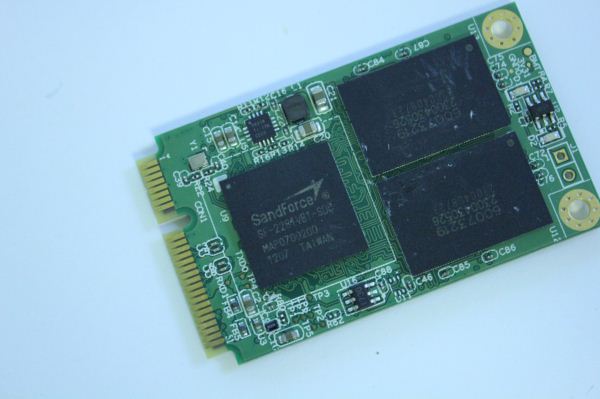
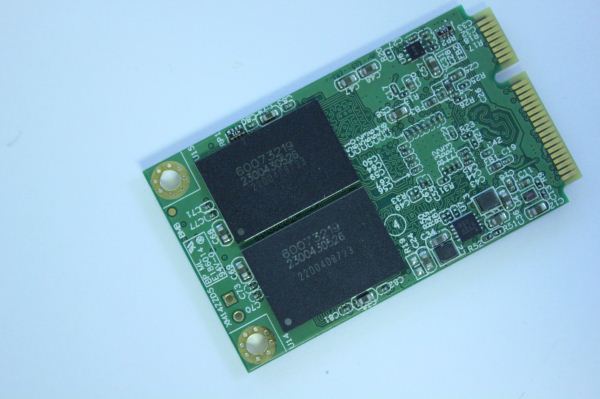
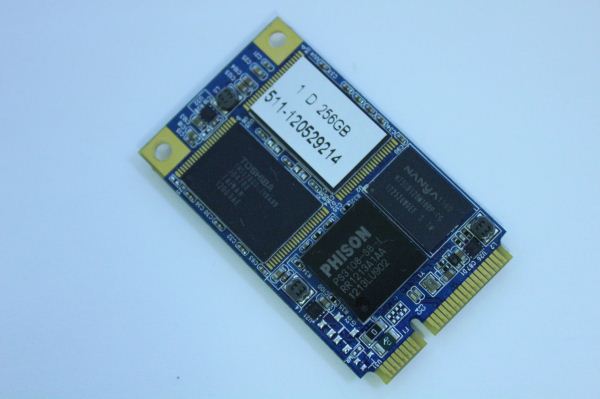
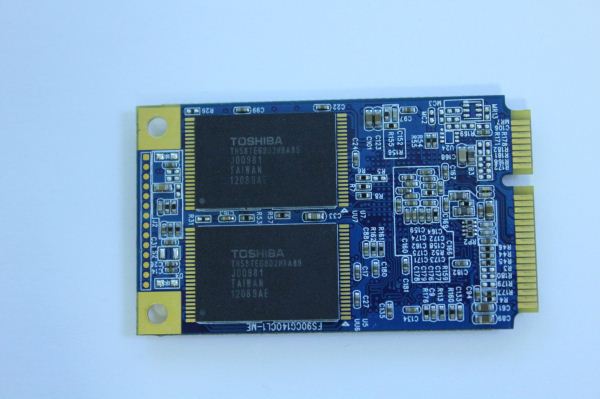
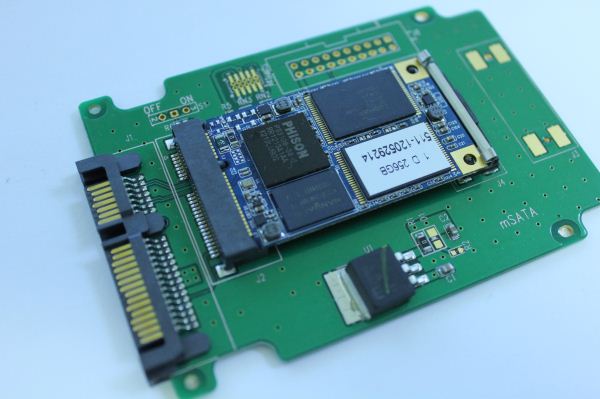








49 Comments
View All Comments
Chupk - Wednesday, January 23, 2013 - link
I love to read your reviews. And just want to give U thumbs up here knowing U R dealing with important exams at the same time while U R publishing high quality reviews.It's interesting to know U R stuck with word processing & HTML editing! >.<
I have long passed my days in University & I'm working as a Consultant in a Hospital. Just want to say the exams U R facing R kinda important. They should be your 1st priority at least for the moment!
Stranman - Wednesday, January 23, 2013 - link
It would be nice to see a comparison or charts of mSata only drives (apples to apples), not apples and oranges. If I'm looking for a mSata drive, I don't care to see standard 2.5" SSD drives listed.Kristian Vättö - Wednesday, January 23, 2013 - link
I thought about that at first but the problem is that we have only reviewed two mSATA SSDs on top of these MyDigitalSSD ones. I do have a couple more in the lab now, so stay tuned for more mSATA stuff. I think it's also worthwhile to compare them to similar SATA 2.5" drives because there is a performance difference and some might go with the 2.5" because of that.Sp4rrowhawk - Wednesday, January 23, 2013 - link
I'm a big thinkpad fan. And while my T410 doesn't have an mSata bay, both the T420 and T430 do.Also I own a home server and have a dedicated system drive. My (new) motherboard has 8 Sata ports or 7 plus 1 mSata port. As such I can't add one more drive but I can save up a 3.5" bay that would otherwise be used by my system drive. So I'm planning on buying one for that use-case. Obviously I don't need 256GB for my system drive though...
ChristopherD - Wednesday, January 23, 2013 - link
Being a traveling photographer, speed and portability is always crucial.mSATA SSD form factor coupled with an external thunderbolt chassis would be a great combo that I would purchase myself. When I have only 30mins to edit and backup a 100GB folder of photos/videos and leave a site an external SSD this small would be great.
Sottilde - Friday, January 25, 2013 - link
It seems that the M4's performance is (surprisingly) just a bit worse than the BP3's, and the M4 mSATA is just a bit more expensive. However, I'm doubtful of the longevity of Toggle-mode MLC; the last review I read on it said that it was guaranteed for only 1000 cycles. In addition this brand has a bit of a dubious name.Given those facts, which mSATA drive would you all choose?
JeBarr - Friday, January 25, 2013 - link
A full size ATX desktop board or even some mATX board users could make use of mSATA PCI-E x1, x4 or x8 with 1, 2, 3 or 4 drives in "raid". These add-on cards already exist but the price is out of reach for most outside of enterprise.I'd much rather swap out a dead mSATA drive rather than purchase another Revo drive that slowly dies.
SSDuser101 - Tuesday, February 12, 2013 - link
MyDigitalSSD has been around a while now. Since 2007 when they introduced the 1st upgrades for netbooks like the Asus 901 Mini PCI-e SSD.They have been selling mSATA SSD longer than anyone with nothing but great reviews.
Also regarding Sottidle’s post about Toshiba toggle nand. He must be thinking of TLC Triple Layer Cell Flash like what ships on the Samsung 840 drives because those do have around a 1K Cycle life span. On the contrary Toshiba Toggle NAND is the best on the market when it comes to MLC flash with a 5K R/W/E cycle minimum.
systemBuilder - Saturday, June 27, 2015 - link
Since 99% of all macbooks are shipped with a disk drive that is too small, because of Apple's horrific pricing policies, well yes, there is a huge market for mSATA drives, but only for macbooks from 2014 and earlier. The new 2015 macbooks have new PCIe drives that run 3x faster, but are not compatible with mSATA.